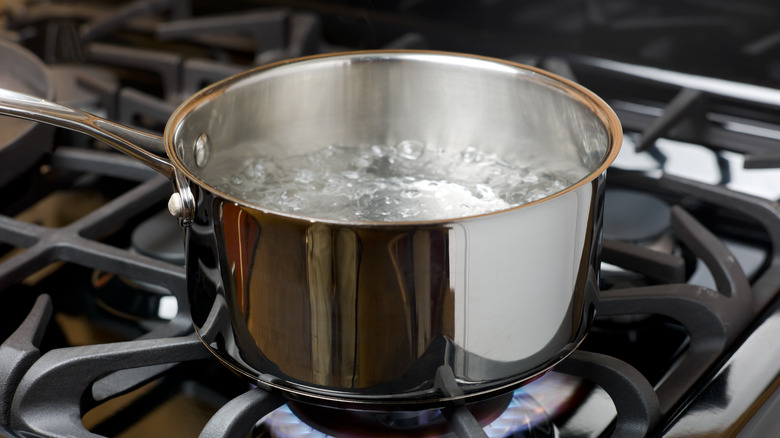Boiling Vs Simmering: What's The Difference?
There are all sorts of cooking techniques out there; virtually every culture has contributed at least one or two unique methods by which to prepare food. But while culinary trends like sous vide or using liquid nitrogen are now all the rage, you can't become a good cook without learning the basics. These building blocks of food preparation are the foundation of learning to cook, so it's important to tell them apart. Sometimes that can be a little tough, though, because you run into two cooking techniques that are conceptually pretty similar.
Such is the case with boiling vs. simmering. The two both involve heating food in water, but that's where the similarities end. Ultimately, it's all about the water temperature involved, as boiling involves exposing the food to a lot more heat. As such, the situations in which you'd want to use each method in cooking are very, very different.
Boiling involves a much higher water temperature
Boiling is one of the most basic cooking techniques out there: you just heat water on the highest setting until it starts bubbling like crazy. While boiling is necessary for certain things — it's the first step in making mashed potatoes, and it's how you make hard-boiled eggs and prepare pasta — it's also not all that interesting. Boiling food like meat and vegetables can have a tendency to turn them to mush if you're not careful, so while it's extremely easy, you don't want to overuse it.
Simmering, by contrast, is cooking food on water at a lower temperature. The boiling point of water is at 212 degrees Fahrenheit, so simmering is anything below that. Basically, you use simmer to slow-cook food, achieving much the same effect as boiling without causing the food's texture to break apart. This is also why turning a stove to the lowest setting is often referred to as turning it to "simmer."
Sometimes you want to use both techniques on the same dish
There are some foods where you want to use both cooking techniques. One of the most obvious is rice, where you bring water to a boil, dump the rice in, then set it to simmer and cover the pot. This achieves the effect of jumpstarting the cooking process at high heat, then settling down to low heat and letting the rice cook slowly the rest of the way.
These aren't the only methods of cooking food in water, either. Braising is conceptually similar to simmering; you use low heat, but in this case you cook in only a small amount of liquid in a tightly-covered pot, most often adding liquids like stock or wine for an extra pop of flavor. Poaching is even more of a low-temperature cooking method than simmering and is designed specifically for delicate foods like eggs. Blanching isn't technically a form of cooking in water, but it's a cooking technique that relies on it: after boiling food, blanching involves immediately dumping it into an ice bath in order to arrest the cooking process (it's most useful for vegetables, where it helps preserve their color and texture).
You can't become a good cook without mastering cooking in water. As long as you know the difference between these techniques, you'll be off to a great start.


